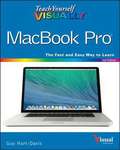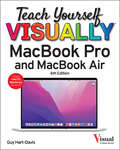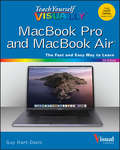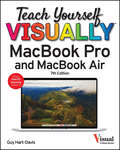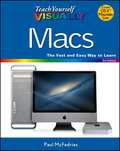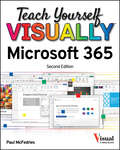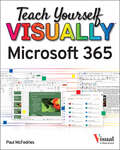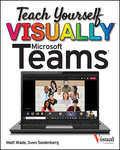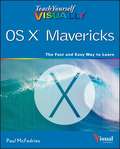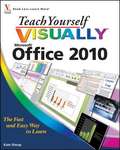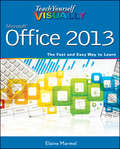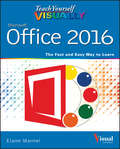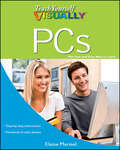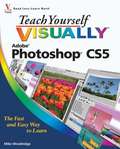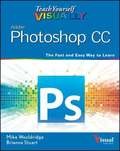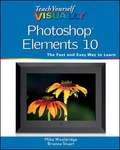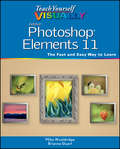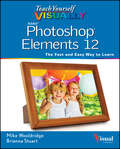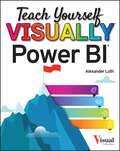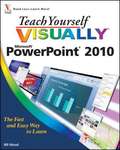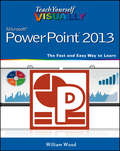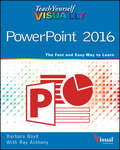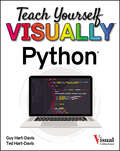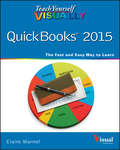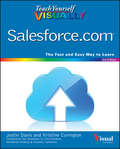- Table View
- List View
Teach Yourself VISUALLY MacBook Pro
by Guy Hart-DavisClear instructions to help visual learners get started with their MacBook ProCovering all the essential information you need to get up to speed with your MacBook Pro, this new edition provides you with the most up-to-date information on performing everyday tasks quickly and easily. From basics such as powering on or shutting down the MacBook Pro to more advanced tasks such as running Windows applications, this visual guide provides the help and support you need to confidently use your MacBook Pro to its full potential.Empowers you to perform everyday tasks quickly and easilyCovers new hardware updates, the latest version of OS X, troubleshooting, iCloud, FaceTime, and moreWalks you through working on the Mac desktop with Mission Control and LaunchpadExplains how to download applications from the Mac App StoreTeach Yourself VISUALLY MacBook Pro, Second Edition is an ideal, fully illustrated guide for learning how to make the most of all your MacBook Pro has to offer.
Teach Yourself VISUALLY MacBook Pro & MacBook Air (Teach Yourself VISUALLY (Tech))
by Guy Hart-DavisGet up to speed with your new MacBook Pro or MacBook Air faster than you thought possible In Teach Yourself VISUALLY: MacBook Pro & MacBook Air, technology educator extraordinaire and bestselling author Guy Hart-Davis delivers a highly illustrated and easy-to-follow guide to using your MacBook Pro or MacBook Air with macOS Monterey. In the book, you’ll get up and running quickly whether you’re brand new to computers or just transitioning from an older Mac or a PC. With the graphics-driven approach used successfully by tens of thousands of readers of the Teach Yourself VISUALLY series, you see exactly what each step of instruction should look like on your own screen and can follow—step-by-step—through the installation process, file management, email, and messaging, and much more. You’ll also: Become expert with the latest macOS version—Monterey—and the newest features that enable you to make the most of your MacBook and the Internet Learn exactly how to handle the most common and useful everyday tasks you need to get stuff done Glean valuable customization tips to make your MacBook work just the way you preferTeach Yourself VISUALLY: MacBook Pro & MacBook Air skips confusing tech jargon in favor of clear pictures, simple instructions, and stepwise guidance that will give you a flying start to using your new MacBook, regardless of your experience level.
Teach Yourself VISUALLY MacBook Pro and MacBook Air (Teach Yourself VISUALLY (Tech))
by Guy Hart-DavisThe visual learner’s ultimate guide to the MacBook Pro, MacBook Air and macOS Catalina Teach Yourself VISUALLY MacBook is your ultimate guide to getting up and running quickly with your new MacBook Pro or MacBook Air! Whether you’re new to computers or transitioning from a PC, this graphics-heavy guide will show you everything you need to know to get the most out of your new laptop. Clear, step-by-step instructions walk you through each task, with screenshots that help you follow along with confidence. You’ll learn how to manage files, work with macOS software, organize photos and media, set up email, access the internet, and adjust settings and preferences to make your MacBook work the way you work. You’ll also explore the features that bring computing to a whole new level, including iCloud, FaceTime, the App Store, and so much more! The Mac has long inspired a legion of loyal fans, and you’re about to find out why. From sleek design to intuitive interface, to an OS that just works, Apple has cornered the market on the high-end computing experience. The MacBook makes sublime computing portable, and this book shows you how to take advantage of all that your MacBook has to offer. MacOS Catalina gives you more of everything you love about Mac. Prepare yourself to experience music, TV, and podcasts in newly designed Mac apps. You can now enjoy your favorite iPad apps on Mac, and even extend your workspace and expand your creativity with iPad and Apple Pencil. Packed with new features and updates to the apps Apple users love, you can now take everything you do up the next level. Get acquainted with the latest macOS version Cataline, and its new features Perform everyday tasks quickly and easily Customize preferences and settings to suit your needs Download new apps, video chat, save to the cloud, and much more! No confusing tech-speak, no vague instructions, and no complex tangents into obscure tasks. This friendly guide is packed with screenshots, easy-to-follow instructions, and a practical sensibility; you’re not launching the space shuttle, you just want to open your email. If you’re ready to explore all that your MacBook can do, Teach Yourself VISUALLY MacBook is your ideal companion.
Teach Yourself VISUALLY MacBook Pro and MacBook Air (Teach Yourself VISUALLY (Tech))
by Guy Hart-DavisThe visual learner's guide to getting up and running with your Apple laptop Teach Yourself VISUALLY MacBook Pro and MacBook Air covers all the vital information you need to start working on your MacBook. With this highly illustrated and easy-to-follow guide, you'll learn to navigate the macOS interface like a pro; customize your desktop with the widgets you need; and get your MacBook working with iCloud, your iPhone, and your iPad. This book's graphical, step-by-step instructions walk you through everything from installation to troubleshooting, helping you to get the most out of the investment you've made in your MacBook. This fully updated edition helps you become a power user of the latest MacBook models and exploit the features in macOS Sonoma, Apple's state-of-the-art operating system, and the apps that come with it. If you prefer to learn visually, this is the book you need. Get up to speed with the latest macOS version, Sonoma, and its new features Perform everyday tasks quickly and easily Customize settings to make macOS and its apps work the way you prefer Communicate via audio and video with FaceTime, via instant messaging with Messages, and via email with Mail Organize your life with Calendar, Contacts, Reminders, Notes, and Maps Make the most of your iCloud account Instead of confusing tech-speak and vague instructions, this guide is packed with screenshots, easy-to-follow instructions, and a practical sensibility. Grab Teach Yourself VISUALLY MacBook Pro and MacBook Air and explore all that your MacBook can do.
Teach Yourself VISUALLY Macs
by Paul McfedriesVisual coverage of the latest Apple hardware and software, including the most popular programsFully updated to cover all the latest changes and features that Macs have to offer, Teach Yourself VISUALLY Macs, 2nd Edition aims at helping visual learners get the most from their Mac hardware and software. Whether you're switching from a Windows machine to a Mac or you're a veteran Mac user looking to maximize all that your system has to offer, this visual guide walks you through everything from managing your photos in iPhoto, creating award worthy home movies with iMovie, browsing the Web with Safari, exploring the ever growing iTunes store, and syncing popular mobile devices like an iPhone or iPad.Targets visual learners interested in getting the most from their MacBoasts full-color screen shots and illustrations as well as straightforward, step-by-step instructionsDemonstrates how to manage your photos in iPhoto, create movies with iMovie, browse the Web, explore the iTunes store, and sync up with an iPhone or iPadWalks you through basic productivity, maintenance, and troubleshooting for a MacTransitions you from working with a PC to a MacTeach Youself VISUALLY Macs, 2nd Edition puts you well on your way to confidently making the most of your Mac.
Teach Yourself VISUALLY Microsoft 365
by Paul McFedriesAn illustrated, A-to-Z, and newly updated guide to mastering Microsoft Office 365 Teach Yourself VISUALLY Microsoft 365, 2nd Edition is a newly revised edition of the easy-to-use and up-to-date visual walkthrough of Microsoft's ubiquitous office products. It#s the fastest and most efficient way to get up to speed on world-famous apps like Word, Excel, and PowerPoint, offering crystal-clear, high-resolution screenshots that show you exactly how to get things done. Tired of confusing, text-based “instructions” that leave you scratching your head and wondering, “Why didn't that work?” Then grab a copy of TYV Microsoft 365, 2nd Edition for a complete, A-to-Z tour of Microsoft 365 that takes you through how to generate sophisticated documents in Word, crunch numbers in Excel, keep your life organized in Outlook, and build attractive and persuasive presentations in PowerPoint. This book shows you how to master basic, foundational features that have been around for years, as well as cutting-edge new additions to the software—like Microsoft's Copilot AI—that make your job easier and make you more productive. From working with files in the cloud to setting up your own local databases in Access, TYV Microsoft 365, 2nd Edition puts the info, screenshots, and instructions you need at your fingertips. Readers will find: Hundreds of hi-res, full-page screenshots that demonstrate Microsoft 365's most useful features Specific instructions on how to get more from your favorite Office 365 apps, like how to add attachments to your Outlook emails or include narration in a PowerPoint presentation Techniques to incorporate artificial intelligence in your everyday work to supercharge your productivity by summarizing Word documents or automatically generating Excel formulas Perfect for anyone looking for an intuitive and visual guide to Microsoft 365 that comes with full-screen images that show you exactly what to do and where to click, Teach Yourself VISUALLY Microsoft 365, 2nd Edition is the simplest and most effective resource for mastering the world's most popular suite of office apps.
Teach Yourself VISUALLY Microsoft 365 (Teach Yourself VISUALLY (Tech))
by Paul McFedriesA fast-paced, useful, and easy introduction to Microsoft 365 For those who need the show as well as the tell, Teach Yourself VISUALLY Microsoft 365 is the visual walkthrough to Microsoft’s latest suite of office products that will get you up-to-speed faster than any other resource on the market. This book offers image- and screenshot-rich tutorials alongside step-by-step instructions so you can see what you need to do to make the most of Microsoft 365. From getting a grip on the most basic Microsoft 365 functions to the advanced, new features known only by power users, the book provides you with the tools you need to make your work more streamlined and efficient. You’ll also get: Up to date—and visually supported—guidance on the major Office apps that are part of Microsoft 365: Word, Excel, PowerPoint, Outlook, and Access Full-color, two-page tutorials that get you up and running fast Easy-to-read instructions and stepwise advice to accompany the informative and crystal-clear imagesIdeal for people using Microsoft 365 for the very first time, Teach Yourself VISUALLY Microsoft 365 is also a can’t-miss resource for long-time users of the software suite who need an introduction to the latest version and Office veterans seeking a refresher on what Microsoft 365 is capable of.
Teach Yourself VISUALLY Microsoft Teams (Teach Yourself VISUALLY (Tech))
by Matt Wade Sven SeidenbergDiscover the power of Microsoft Teams with this intuitive and timely new guide Microsoft Teams is unlocking the potential of remote work and virtual meetings at a time when they couldn’t be more necessary. Its feature-rich interface and ease-of-use promise to bring your team together—as long as you can harness its full suite of capabilities. In Teach Yourself VISUALLY Microsoft Teams, Microsoft experts and authors Matt Wade and Sven Seidenberg turn their years of engineering and IT experience loose on the virtual collaboration software now used by over one hundred million people across the globe. Using the book’s huge collection of vibrant and full-sized images and walkthroughs, you’ll see exactly what you need to do in order to: Realize the key benefits of Teams by using its messaging and video-conferencing capabilities to stay connected with your colleagues Manage multiple teams and channels to use Teams across your organization Extend the functionality of Teams by using additional apps and add-ons Learn valuable tips, best practices, and work-arounds to make the most of and avoid the landmines in Teams Rapidly becoming the central hub for working in Microsoft 365, Microsoft Teams promises to transform the way you work and communicate. And you’ll master it faster and easier by using this ultimate guide to get the most out of Microsoft’s latest and greatest software!
Teach Yourself VISUALLY OS X Mavericks
by Paul McfedriesClear, step-by-step instruction guides you through OS X MavericksIf you want to get quickly up to speed on the newest (and now cat-free) OS X operating system, OS X Mavericks, this easy-to-follow book is just the ticket. Designed for visual learners, Teach Yourself VISUALLY OS X Mavericks uses rich, full-color screenshots and illustrations to show rather than tell you how to use Mavericks. You'll learn how to customize your Mac, enjoy digital media, connect common peripherals, and get the most out of the very latest enhancements, including iBooks, Maps, iCloud, and Calendar.Shows you how to use and optimize the newest OS X operating system, MavericksUses step-by-step instruction to guide you through common tasks and cool featuresFeatures full-color screenshots or illustrations on almost every pageCovers the latest features, technologies, and enhancementsSurf's up and the water is fine, so jump into OS X Mavericks with Teach Yourself VISUALLY OS X Mavericks!
Teach Yourself VISUALLY Office 2010
by Kate ShoupMaster the new version of Microsoft Office with this easy, visual guideThe popular Microsoft Office suite has been revamped to provide new features, including Web applications that can be accessed from anywhere and a new, streamlined Ribbon. If you learn better with visual instructions, this full-color guide is just what you need.Covering Word, Excel, PowerPoint, Outlook, Access, and Publisher, this book is filled with step-by-step instructions and full-color screen shots that show you exactly what you'll see at each step. You'll also get instruction on the new Office Internet and graphics tools, as well as how to tackle dozens of common tasks in each application.Ideal for visual learners, this guide covers the entire Office suite: Word, Excel, PowerPoint, Outlook, Access, and PublisherIntroduces the new Microsoft Office features, including Office Internet and graphics toolsProvides step-by-step instructions for common tasks in each applicationFull-color screen shots illustrate what you see on the screen every step of the wayTeach Yourself VISUALLY Office 2010 gets you up and running with Office 2010 quickly and easily, so you can take advantage of all the enhanced features.
Teach Yourself VISUALLY Office 2013 (Teach Yourself VISUALLY (Tech) #143)
by Elaine MarmelLearn the new Microsoft Office suite the easy, visual way Microsoft Office 2013 is a power-packed suite of office productivity tools including Word, Excel, PowerPoint, Outlook, Access, and Publisher. This easy-to-use visual guide covers the basics of all six programs, with step-by-step instructions and full-color screen shots showing what you should see at each step. You'll also learn about using Office Internet and graphics tools, while the additional examples and advice scattered through the book give you tips on maximizing the Office suite. If you learn best when you can see how things are done, this book is for you. Shows you how to use Microsoft Office 2013 with easy-to-follow, step-by-step instructions illustrated with full-color screen shots Covers Word, Excel, PowerPoint, Outlook, Access, and Publisher Includes additional information on using Office Internet and graphics tools Designed to help visual learners read less and learn more Teach Yourself VISUALLY Office 2013 shows you how to use all six tools in the Office suite, step by step.
Teach Yourself VISUALLY Office 2016
by Elaine MarmelQuickly and efficiently learn the latest version of Office Are you a visual learner who wants to spend more time working in Microsoft Office than trying to figure out how the programs actually work? Teach Yourself Visually Office offers you a straightforward, visual approach to making your work life more efficient and productive using the latest version of the Microsoft Office suite. Featuring visually rich tutorials and step-by-step instructions that will help you make the most of this power-packed suite of office productivity tools, it covers everything you need to compute, document, graph, chart, present, and organize your way to success in the workplace--from the most basic to the most advanced. The Microsoft Office suite can be intimidating to the uninitiated, but it doesn't have to be. Through a series of easy-to-follow, full-color two-page tutorials, you'll quickly get up and running on working in Word, excelling at Excel, powering through PowerPoint, keeping in touch on Outlook, managing data in Access, and propelling your way through Publisher like a pro! Highly visual tutorials and step-by-step screenshots make lessons easy to follow and understand Helps you grasp the basic functions of Microsoft Office--and beyond Walks you through Microsoft Office's new features Demonstrates how to use the Microsoft Office suite to make your work life more streamlined and effective Whether you're looking to discover what's new in the latest release of Microsoft Office or don't know Access from Word, this visual guide makes learning easy!
Teach Yourself VISUALLY PCs
by Elaine MarmelPCs made easy for visual learnersBeginning computer users who want to see visually how things are done will learn quickly and easily with this full-color, step-by-step guide. Screen shots show clearly what you will see at each step, and numbered instructions guide you through dozens of common PC tasks. You'll learn all the basics, plus some intermediate topics including how to use multimedia applications, the Internet, wireless technologies, Windows 7, Office 2010, mobile devices, and key security processes.Computer literacy is essential in today's world; this full-color guide makes it easy for visual learners to get up to speed quicklyCovers basic operating procedures, hardware and software, Windows 7, networks, the Internet, wireless devices, using multimedia applications, Office 2010, syncing with mobile devices, virus protection, and much moreEach lesson is fully illustrated with screen shots and numbered, step-by-step instructionsIf you learn best when someone shows you how it's done, Teach Yourself VISUALLY PCs is the computer book you've been looking for.
Teach Yourself VISUALLY Photoshop CS5
by Mike WooldridgeGets visual learners up to speed quickly on the newest Photoshop releasePhotoshop is the gold standard for image-editing programs and is used by professional photographers, graphic designers, and Web designers as well as hobbyists. Designed for those who learn best visually, this full-color guide has been completely updated to cover the newest release of Photoshop. Previous editions have sold more than 150,000 copies.Photoshop is the industry standard for image-editing software used in both print and digital media, with more than four million users worldwide; the latest version includes new functionality and enhanced tools People who learn more easily when they can see how something is done will quickly grasp essential Photoshop concepts and procedures in this visual, step-by-step formatCovers importing photos from digital cameras and scanners, retouching and repairing, enhancing digital images, adding custom 3D effects, editing images for the Web, creating a Web photo gallery, incorporating graphics into desktop publishing programs, color management, using layers and filters, compositing, and moreWith step-by-step instructions and full-color screen shots to demonstrate each task, Teach Yourself VISUALLY Photoshop makes learning easy.Note: CD-ROM/DVD and other supplementary materials are not included as part of eBook file.
Teach Yourself VISUALLY Photoshop CS6
by Mike Wooldridge Brianna StuartGets visual learners up to speed on the newest enhancements in Photoshop Photoshop is constantly evolving, and the newest version offers great new tools for photographers. This popular guide gets visual learners up to speed quickly; previous editions have sold more than 150,000 copies. With colorful screen shots illustrating the step-by-step instructions, this book is perfect for Photoshop newcomers and for visual learners who are upgrading from an earlier version. It covers setting up the software, importing images from the camera, using all the tools, creating an online gallery, and more. Covers the most important features of Photoshop CS6, including importing photos from a digital camera, retouching and repairing damaged photos, enhancing digital images, and adding custom 3-D effects Explains how to edit images for the web, create an online photo gallery, and incorporate graphics into desktop publishing programs Explores color management, using palettes, compositing, using layers, applying gradients, setting type, and working with filters Features step-by-step instructions and full-color illustrations designed for those who learn best when they see how things are done Teach Yourself VISUALLY Photoshop CS6 gets visual learners ready to take advantage of everything the newest version has to offer.
Teach Yourself VISUALLY Photoshop Elements 10
by Mike Wooldridge Brianna StuartSee what to do and how to do it in this visual guide to Photoshop Elements 10 If you want practical coverage of the most important features of Photoshop Elements 10, this book is for you. Packed with step-by-step instructions illustrated with full-color screen shots, this book clearly shows you how to do tasks, rather than using lengthy explanations. Even better, the book includes an associated website with all the images in the book available for download, so you can get hands-on practice as you go. It's an efficient, easy-to-follow way to get up to speed on the latest and best that Photoshop Elements 10 has to offer. A visual guide to Photoshop Elements 10, perfect for visual learners Helps you build your skills through clear, step-by-step instruction and ample, full-color illustrations Covers important new features such as importing photos from digital cameras and scanners, retouching and repairing damaged photos, enhancing digital images, perfecting group shots with Photomerge, and editing images for posting on the web Also covers using the sharpness interface to correct blurry images, exploring the Curves tool to adjust contract and brightness, and organizing images with auto-stacking Get the very most out of Photoshop Elements 10 with Teach Yourself VISUALLY Photoshop Elements 10.
Teach Yourself VISUALLY Photoshop Elements 11 (Teach Yourself VISUALLY (Tech) #120)
by Mike WooldridgeFull-color, step-by-step instruction for using the new Photoshop Elements 11 Covering the most important features of Photoshop Elements 11, this book is packed with step-by-step instructions illustrated with full-color screen shots that clearly shows you how to do tasks, instead of resorting to lengthy explanations. Even better, the book includes an associated website with all the images in the book available for download, so you can get hands-on practice as you go. With this book, veteran author Mike Wooldridge gets up to speed on the latest and best that Photoshop Elements 10 has to offer. Walks you through the improved organizational and navigational tools that will help you categorize images Details the enhanced tool for converting color images to B&W as well as the Flash-based web gallery templates to display images Covers importing photos from digital cameras and scanners, retouching and repairing damaged photos, enhancing digital images, perfecting group shots with Photomerge, and editing images for posting on the web Helps you utilize the sharpness interface to correct blurry images as well as the Curves tool to adjust contract and brightness Teach Yourself VISUALLY Photoshop Elements 11 makes learning the new Photoshop Elements elementary!
Teach Yourself VISUALLY Photoshop Elements 12 (Teach Yourself VISUALLY (Tech))
by Mike WooldridgeAre you a visual learner? Do you prefer instructions that show you how to do something — and skip the long-winded explanations? If so, then this book is for you. Open it up and you'll find clear, step-by-step screen shots that show you how to tackle more than 160 Photoshop Elements tasks. Each task-based spread covers a single technique, sure to help you get up and running on Photoshop Elements 12 in no time. You'll learn to: Use both the Organizer and Editor Import photos from various sources Enhance lighting and color Restore old photos and add effects Save, back up, and share photos Designed for visual learners Two-page lessons break big topics into bite-sized modules Succinct explanations walk you through step by step Full-color screen shots demonstrate each task Helpful sidebars offer practical tips and tricks
Teach Yourself VISUALLY Power BI (Teach Yourself VISUALLY (Tech))
by Alexander LothA comprehensive and fully visual guide to Microsoft Power BI Teach Yourself VISUALLY Power BI collects all the resources you need to master the everyday use of Microsoft's powerful data visualization software and delivers them in a single, easy-to-use volume. Fully illustrated, step-by-step instructions are combined with crystal-clear screenshots that walk you through the basic and advanced functions of Microsoft Power BI. Teach Yourself VISUALLY Power BI offers the best visual learning techniques with complete source material about the interface and substance of Power BI, as well as: Stepwise guidance on working with, transforming, and processing data sources Instructions for customizing data visualizations to create informative and presentation-ready charts and graphs Full-color, two-page tutorials on the more advanced features of Power BI, including app integrations and data access with DAX The fastest, easiest way for visual learners to get a handle on Microsoft Power BI, Teach Yourself VISUALLY Power BI is a can't-miss resource, loaded with useful tips for newbies and experts alike.
Teach Yourself VISUALLY PowerPoint 2010
by Bill WoodFast, easy way to get the very most out of PowerPoint 2010Present your work in style in a PowerPoint presentation using the tips and techniques in this visual guide to PowerPoint 2010. It covers the basics, as well as all the exciting new changes and additions in a series of easy-to-follow, full-color, two-page tutorials. Learn how to create slides, dress them up using templates and graphics, add sound and animation, and more. If you're looking for a practical, "show me, don't tell me" guide to PowerPoint 2010, this is the book for you.Helps you create presentations with greater impact using PowerPoint 2010, the latest generation of Microsoft's presentation software; PowerPoint 2010 is part of the new Microsoft Office 2010 suite of productsIntroduces PowerPoint 2010's new features, including the new Reading View, new transitions tab, and a new screenshot functionShows you how to create slides, dress them up with templates and graphics, add sound and animation, and present in a business or Internet settingFeatures easy-to-follow, full-color, two-page tutorialsAdd more power to your PowerPoint presentations with this practical guide.
Teach Yourself VISUALLY PowerPoint 2013 (Teach Yourself VISUALLY (Tech) #138)
by William WoodA straightforward, visual approach to learning the new PowerPoint 2013! PowerPoint 2013 boasts updated features and new possibilities; this highly visual tutorial provides step-by-step instructions to help you learn all the capabilities of PowerPoint 2013. It covers the basics, as well as all the exciting new changes and additions in a series of easy-to-follow, full-color, two-page tutorials. Learn how to create slides, dress them up using templates and graphics, add sound and animation, and more. This book is the ideal "show me, don't tell me" guide to PowerPoint 2013. Demonstrates how to create memorable and captivating presentations using PowerPoint 2013, the latest generation of Microsoft's presentation software Walks you through PowerPoint 2013's new features, including new wide-screen themes and variants, improved collaboration tools, and an enhanced Presenter View Shows you how to create slides, dress them up with templates and graphics, add sound and animation, and present in a business or Internet setting Features easy-to-follow, full-color, two-page tutorials With Teach Yourself VISUALLY PowerPoint 2013, you have the power to make a remarkable presentation!
Teach Yourself VISUALLY PowerPoint 2016 (Teach Yourself VISUALLY (Tech))
by Barbara BoydThe uncomplicated PowerPoint guide designed specifically for visual learners Are you a visual learner who wants to spend more time working on your presentations than trying to figure out how to create them? Teach Yourself Visually PowerPoint offers you an effortless approach to creating winning presentations with the latest version of PowerPoint. This accessible resource features visually rich tutorials and step-by-step instructions that will help you understand all of PowerPoint's capabilities—from the most basic to the most advanced. With Teach Yourself Visually PowerPoint, you'll learn how to create slides, dress them up using templates and graphics, add sound and animation, present in a business or Internet setting, and so much more. Covering the latest additions and changes in the new version of PowerPoint, a series of easy-to-follow, full-color tutorials helps you to quickly get up and running using PowerPoint like a pro! Highly visual tutorials and step-by-step screenshots make lessons easy to follow and understand Helps you learn the basic functions of PowerPoint—and beyond Walks you through PowerPoint's latest features Demonstrates how to create memorable and captivating presentations using PowerPoint Do you prefer instructions that show you how to do something—and skip the long-winded explanations? If so, Teach Yourself Visually PowerPoint is for you.
Teach Yourself VISUALLY Python (Teach Yourself VISUALLY (Tech))
by Guy Hart-Davis Ted Hart-DavisA simple, straightforward, and hands-on roadmap to the world of computer programming with Python Teach Yourself VISUALLY: Python is your personal guide to getting you started in programming. As one of the world's most popular—and most accessible—coding languages, Python is your gateway into the wide and wonderful world of computer science. This hands-on guide walks you through Python step by clearly illustrated step, from writing your very first Python code in a terminal window or the VS Code app through to creating your own lists, dictionaries, and custom classes. In the book, you’ll learn to: Install Python and the tools you need to work with it on Windows, macOS, and Linux Work with files and folders, manipulate text, and create powerful functions that do exactly what you want Write clean code that makes decisions effectively, repeats actions as needed, and handles any errors that occur A must-have resource for aspiring programmers starting from the very beginning, Teach Yourself VISUALLY: Python is also an indispensable handbook for programmers making a transition from another language.
Teach Yourself VISUALLY QuickBooks 2015
by Elaine MarmelThe visual way to master QuickBooks XIf you learn better by seeing rather than wading through confusing text, then this visual guide is for you! Teach Yourself Visually QuickBooks X gives you hundreds of succinctly captioned, step-by-step screenshots that reveal how to master QuickBooks X and get your business finances in working order. QuickBooks X is the world's most popular accounting software, but that doesn't mean it's easy to figure out on your own. In this great guide, you'll find tons of visual references that make it easy to navigate QuickBooks X. Learn how to store and process company names, addresses, and account information, track accounts payable, compile and integrate data, produce reports for tracking and analyzing financial data, and so much more--all with visual references that won't make you pull your hair out!Find out how to choose a company identity and set up your sales taxCut through the jargon and see how to edit paycheck information and track employees' time recordsCreate invoices and estimates with QuickBooks XFollow along with easy-to-decipher screenshots that make it clear how to pay bills online and print financial reportsIf you're a visual learner interested in getting your business finances in order, this see-as-you-go guide makes it easier to master QuickBooks X without the headache of trying to figure out hard-to-read text.
Teach Yourself VISUALLY Salesforce.com (Teach Yourself VISUALLY (Tech))
by Justin Davis Kristine CuringtonThe highly visual, step-by-step guide to getting the most out of Salesforce.com Teach Yourself VISUALLY Salesforce.com, 2nd Edition is your ideal guide to getting up to speed on the world's number-one on-demand customer relationship management (CRM) system. With full color screenshots and step-by-step instructions, this highly visual manual shows you everything you need to know to get the most out of Salesforce.com. You'll be walked through each step of the entire process, from choosing the right edition and customizing your service to capturing leads, inputting contacts, tracking correspondence, reviewing reports, and more. This updated edition covers the newest features and tools that make your business run more smoothly, so you can get up and running quickly. This book is your ultimate guide to optimizing Salesforce.com capabilities, helping you leverage your data into added value for your business. Choose the right Salesforce.com edition to suit your needs Master the latest and most helpful features Personalize your system for a tailor-made CRM solution Manage accounts, develop contacts, track inventory, and more
